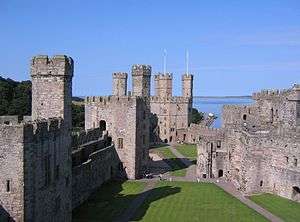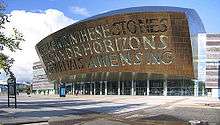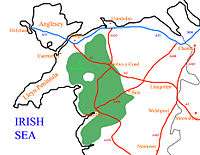Tourism in Wales
Wales is an emerging tourist destination, with 8,078,900 visitors to National Trust and Wales Tourist Board destinations in 2002.[1] As of 2017 the tourism industry in Wales has been estimated to have an annual turnover of £4.8 billion.[2]
_(32306541014).jpg)
In 2005 tourism contributed to the economy of Wales supporting over 100,000 service-sector jobs, more than 8% of the country's workforce. The most popular activities undertaken by tourists in Wales were walking, shopping, hiking in the mountains and visiting historic attractions, museums and galleries. 970,000 overseas tourists visited Wales in 2015 spending £410m.[3] The main countries of origin of overseas visitors were the Republic of Ireland, the United States and Germany. The majority of tourism however, is from other parts of the UK (predominantly England).[4]
The capital, Cardiff is the most popular area in Wales for tourists, with 14.6 million visitors in 2009,[5] which provides 26,300 jobs in the sector. In 2004, tourists spent the most money in Gwynedd, followed by Conwy and Cardiff.[6]
Reasons

The varied landscape of Wales attracts tourism. There are three national parks: the Brecon Beacons National Park, the Snowdonia National Park and the Pembrokeshire Coast National Park. Popular activities in the national parks include hill walking, hiking, canoeing, mountain biking, kayaking and climbing. Wales is also becoming increasingly popular for 'extreme' sports, such as surfing, hang gliding and downhill cycling (in which Wales hosts the 'Dragon Downhill Series'). The terrain of Wales has also attracted the World Rally Championship (WRC). The Wales Rally GB is held annually. The 2005 Wales Rally GB saw the first WRC stage to be set indoors, at the Millennium Stadium. In Cardiff, the regenerated Cardiff Bay area is one of the most popular destinations.
Wales' history and culture also attract tourists. The Museum of Welsh Life, which focuses largely on the industrial past of Wales, is currently the most popular tourist attraction in Wales, attracting over 600,000 visitors annually. The scars of the industrial revolution and Wales' industrial heritage can still be seen on parts of the Welsh landscape today. Many other places of historical interest attract large numbers of tourists: for example the many castles, such as Caernarfon Castle and Caerphilly Castle—most of them built to enable or to consolidate the English conquest of Wales, during the reign of the English king Edward I.
Another increasingly popular reason for visiting Wales, as with the rest of the United Kingdom—especially for those from North America—is genealogy, with many visitors coming to Wales to explore their family and ancestral roots. 1.8 million United States citizens are estimated to have Welsh ancestral roots, including former presidents, Abraham Lincoln and Thomas Jefferson.[7]
History

The Wye Valley witnessed the birth of British tourism in the 18th century. The area became widely known after Observations on the River Wye by the Reverend William Gilpin was published in 1782. The first illustrated tour guide to be published in Britain, it helped travellers locate and enjoy the most picturesque places, such as Tintern Abbey. A particular attraction of the Wye Valley was its river scenery, and the many guidebooks, engravings and paintings encouraged a continuing steady stream of visitors which grew after the building of a new turnpike road up the valley in 1822 and the opening of a rail line in 1865.
However, when George Borrow wrote Wild Wales in 1862 it is clear from his descriptions that the notion of tourism in more mountainous parts of Wales hardly existed except for the most intrepid traveller. Indeed, he records that many locals regarded the mountainous and wild landscapes as monstrous and ugly rather than romantic or picturesque. However, later in the 19th century the concept of mountains and valleys as both interesting and visually pleasing landscapes developed; and North Wales in particular benefited, as towns and villages such as Betws-y-Coed developed to accommodate the increasing numbers of visitors.
The changing face of industrialisation in the North West of England and in the Midlands, with increasing pay rates and the provision of paid time off for industrial workers, allowed many people to enjoy an annual holiday for the first time. Many chose to visit seaside resorts such as Llandudno, Prestatyn and Rhyl in North Wales, Aberystwyth and Barmouth in Mid Wales and Barry, Tenby, Swansea and Penarth in South Wales, which among others were developed to respond to this trend.
Infrastructure
Wales is connected to the rest of the United Kingdom (its principal tourist market) by road, rail and domestic flights. The M4 Motorway connects South and West Wales with Southern England and London. The A55 road is the principal route linking North Wales with North West England.
There are several rail links between England and Wales, and trains run to Cardiff Central, Newport and Swansea from London Paddington, and to Cardiff Central from Portsmouth, Gloucester, Birmingham New Street, Manchester Picadilly, Nottingham and Newcastle. Cardiff Central offers connections to the South Wales Valleys, the Vale of Glamorgan and West Wales, and Swansea offers connections to West Wales. There are direct services from London Euston and Birmingham to Holyhead via the North Wales Coast. Internally, there are services from Cardiff to Holyhead.
Cardiff Airport has domestic and some international flights. Some budget airlines operate from Cardiff to Europe, Africa and North America. Internally, there are twice daily return flights from Cardiff to Anglesey with Highland Airways. Many daily flight operate to and from other major UK cities such as Newcastle, Edinburgh, Glasgow, Aberdeen and Belfast.
The country is also connected to Ireland by car ferry services operating daily from Welsh ports, principally Holyhead. These services are frequent and usually operated by fast ferries.
Tourist destinations


Many towns and cities in Wales are popular with tourists, including:
- Cardiff is the capital and largest city. The city has three major performing arts venues: the Wales Millennium Centre, St David's Hall and New Theatre. Other tourist attractions include Cardiff Castle, Millennium Stadium, SWALEC Stadium, National Museum of Wales, Museum of Welsh Life, Llandaff Cathedral, Castell Coch, St. David's and in Cardiff Bay, Techniquest, Cardiff International Pool, Cardiff International White Water, the Senedd and the Pierhead Building. There is an unstaffed Tourist Information Centre in the city centre's Old Library.[8]
- Swansea is the second-largest city. Attractions here include the National Waterfront Museum, Dylan Thomas Centre, Plantasia, Oystermouth Castle, Mumbles Pier and the beach and promenade along Swansea Bay and the adjoining Gower Peninsula. The Swansea Valley, which runs north towards Brecon is home to the National Showcaves for Wales, Wales Ape and Monkey Sanctuary and Craig-y-Nos Castle.
- Newport is the third-largest city in Wales. An influx of visitors occurred in 2010 when the city hosted golf's Ryder Cup at the Celtic Manor Resort. Attractions include Tredegar House and Gardens, the Transporter Bridge, the ancient Roman fortress at Caerleon, and St. Woolos Cathedral. The Big Pit National Coal Museum is at Blaenavon, 15 miles to the north.
- Merthyr Tydfil was the location for the world's first locomotive-hauled railway journey, on 21 February 1804 on the tramway of the Penydarren Ironworks. Merthyr Tydfil is set among forests and hills.
- St David's in Pembrokeshire is arguably the UK's smallest city; it is the resting place of St David and a gateway to the Pembrokeshire Coast National Park and Pembrokeshire Coast Path which also runs through the seaside towns of Tenby and Saundersfoot.
- Bangor is between the mountains of Snowdonia and the Menai Strait and close to Anglesey. Bangor lies at the western end of the North Wales Path, a 60-mile long-distance coastal walking route, and is close to the Menai Suspension Bridge, one of the first modern suspension bridges in the world.
- Barry is a seaside town 9 miles SW of Cardiff. Its seaside resort, Barry Island, is known for its beach and Barry Island Pleasure Park.
- Hay on Wye, the "town of books" famed for its numerous second hand bookshops and its festivals, the Hay Festival and the How the Light Gets In festival.
- Aberystwyth, a seaside university town, known as the cultural capital of Wales. Home of the National Library of Wales, Aberystwyth Arts Centre, Aberystwyth University and Vale of Rheidol Railway.

- The Snowdonia National Park (Welsh: Eryri) is a region in north Wales and a national park of 823 square miles (2,130 km2) in area. It was the first to be designated of the three National Parks in Wales, in 1951.
 Map of Snowdonia
Map of Snowdonia - Llanberis, at the foot of Snowdon and home to the famous Snowdon Mountain Railway has a number of attractions including the Llanberis Lake Railway, National Slate Museum, Electric Mountain Visitor Centre which takes you inside one of the largest Hydro Electric power stations inside a mountain as well as walking, climbing, water and cycling activities. Llanberis also offers great shopping and eating such as the old LMS mainline station Llanberis railway station now Llanberis Art & Craft and Coffee Pot.
Many features of the Welsh landscape that are popular with visitors, include:
- Snowdon in Snowdonia is the highest mountain in Wales and a popular mountaineering and walking destination. There are multiple path's up the peak as well as the Snowdon Mountain Railway for those looking for a gentler option.
- Pen y Fan is the highest peak in the Brecon Beacons in South Wales.
- Wye Valley AONB includes Tintern Abbey and Chepstow Castle.
- Offa's Dyke Path is a long distance footpath on the English border in the historic Welsh Marches.
- Taff Trail is a foot and cycle path running along the River Taff through the city and countryside, from Cardiff Bay to Brecon.
- Glyndŵr's Way is a long-distance trail between Knighton and Welshpool in Powys.
- The Gower Peninsula was the first area in the United Kingdom to be designated as an Area of Outstanding Natural Beauty, in 1956. Gower has a number of castles and sandy beaches.
- The Vale of Neath stretching from the town of Neath to the foothills of the Brecon Beacons National Park has several waterfall attractions along the length of the valley and contains the historic Neath Canal.
- The Wales Coast Path, an 870 mile long-distance footpath which follows the whole of the coastline of Wales.
There are several independent attractions that are popular with visitors:
- Llanberis offers the Snowdon Mountain Railway, National Slate Museum, the Llanberis Lake Railway, Electric Mountain and Padarn country park.
- Oakwood Theme Park, Pembrokeshire
- National Botanic Garden of Wales, Carmarthenshire
- Great Little Trains of Wales
- Folly Farm Adventure Park and Zoo
- Brecon Mountain Railway
See also
- List of Blue Flag Beaches of Wales
- Museums in Wales
- Tourism in England
- Tourism in Scotland
- Most visited museums in the United Kingdom
References
- "Visitors to tourist attractions". Welsh Assembly Government. Archived from the original (Microsoft Excel spreadsheet) on 6 August 2006. Retrieved 25 April 2011.
- "Huge increase in visitor spending in Wales". gov.Wales. 12 September 2017. Retrieved 13 October 2018.
- "This page provides an overview of facts and figures on tourism in Wales". gov.Wales. 2 August 2016. Retrieved 13 October 2018.
- Welsh Assembly Government Fast Facts
- Abby Alford "Report highlights booming tourist trade in Cardiff". Retrieved 27 October 2010.
- "Cardiff visitors spent £456 million". News Wales. 8 September 2005. Archived from the original on 7 September 2012.
- "European Heritage in America". Archived from the original on 15 October 2007. Retrieved 25 April 2011.
- "No more tourist information staff in Cardiff city centre, but businesses say they hope giving hotel staff city tour will help", Wales Online, 23 March 2015. Retrieved 23 January 2016.
External links
| Wikivoyage has a travel guide for Wales. |
- Wales travel and tourism at Curlie
- Visit Wales
- Welsh Assembly Government
- Attractions North Wales (Funded by Tourism Partnership North Wales)
